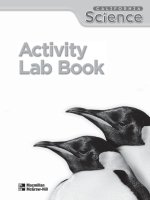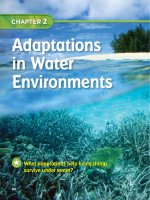- Trang chủ >>
- THPT Quốc Gia >>
- Hóa
California science grade 3 (7)
Bạn đang xem bản rút gọn của tài liệu. Xem và tải ngay bản đầy đủ của tài liệu tại đây (8.93 MB, 42 trang )
CHAPTER
2
Adaptations
in Water
Environments
What adaptations help living things
survive under water?
84
Lesson 1
The Water Planet
PAGE
88
Lesson 2
Life in an Ocean
PAGE
98
Lesson 3
Life in the Wetlands
PAGE
110
3 LS 3. Adaptations in physical structure or behavior
may improve an organism’s chance for survival.
85
Literature
Magazine Article
ELA R 3.2.2. Ask
questions and support
answers by connecting prior
knowledge with literal
information found in, and
inferred from, the text.
ELA W 3.1.1. Create a single
paragraph: a. Develop a topic
sentence. b. Include simple
supporting facts and details.
86
Dragons
Dra
gons
of the
Sea
from Ranger
Rick
by Elizabeth Schleichert
Hi. That dude with the stunning
headdress and cool, matching
outfit in the photo at left is me,
Lennie. We leafy seadragons are
the best-dressed fish around. Yep,
that’s right. We’re fish—seahorse
cousins, as a matter of fact. . . .
Where would you find us? In the
leafy seadragon
ocean off southern Australia. . . .
Predators have a hard time
finding us because we look so much like seaweed swaying
in the current. Being camouflaged helps us get a meal too.
Baby shrimp and other tasty treats drift past us. We often
reach out and suck them right up with our long, tube-like
snouts. So our strange looks really work for us!
Write About It
Response to Literature In this article, you learned that
looking like seaweed keeps leafy seadragons safe in
their environment. What special structures do you have
that keep you safe? For example, how does your nose
protect you? Do some research. Write a report about
how your body keeps you safe.
-Journal Write about it online @ www.macmillanmh.com
87
Lesson 1
The Water Planet
Green sea turtles live in oceans throughout
the world. Can all water plants and
animals live in all water environments?
88
ENGAGE
Building block lesson for 3 LS 3.a. Students know plants and animals have
structures that serve different functions in growth, survival, and reproduction.
• 3 LS 3.b. Students know examples of diverse life forms in different environments,
such as oceans, deserts, tundra, forests, grasslands, and wetlands.
Can ocean animals live and
grow in fresh water?
Materials
Form a Hypothesis
Can brine shrimp grow in fresh water and salt water?
Test Your Hypothesis
2 jars
Fill each jar with 480 mL of water. Put two
tablespoons of sea salt in one jar. Label the
jars Fresh Water and Salt Water.
measuring
cup and
water
Step
measuring
spoons
Add one teaspoon of brine shrimp eggs to
each jar.
Observe Watch what develops in each jar
brine shrimp
eggs
sea salt
hand lens
over the next few days. Use a hand lens.
Step
Draw Conclusions
Can ocean animals live and grow in a
freshwater environment?
Infer Are oceans freshwater or saltwater
environments?
Explore
More
Experiment Does temperature affect the
hatching of brine shrimp eggs? Design an
experiment to find out.
3 IE 5.e. Collect data in an investigation and analyze
those data to develop a logical conclusion.
89
EXPLORE
What is a water environment?
C Main Idea
3 LS 3.a
3 LS 3.b
Earth’s water
environments differ in
their salt content, depth,
and temperature.
C Vocabulary
saltwater environment ,
p. 91
freshwater environment ,
p. 91
brackish environment ,
If you could look at Earth from space,
you would see a blue, watery world.
Almost three quarters of our planet is
covered by water.
Oceans, lakes, ponds, rivers, streams,
and wetlands make up Earth’s water
environments. These environments are
different from one another in many
ways. One of the biggest differences is
in the amount of salt the water in each
environment has.
p. 91
depth , p. 92
Earth’s Water
-Glossary
@
www.macmillanmh.com
C Reading Skill
Summarize
=
salt water (970 buckets)
=
=
fresh water in rivers, lakes,
streams and ponds (3 buckets)
fresh water in ice and underground
sources (27 buckets)
Ac[[O`g
C Technology
Explore biomes with
the Secret Agents.
90
EXPLAIN
If Earth’s water supply
were poured into
1,000 buckets, only 30
buckets would contain
fresh water. The rest
would be salt water.
Saltwater environments have
water that is very salty. Oceans and
seas are saltwater environments.
Saltwater environments are also
called marine environments.
Freshwater environments
A Earth is called the water
planet. From space you
can see that most of
Earth’s surface is
covered with water.
Read a Diagram
Is most of Earth’s water salt
water or fresh water?
Clue: Compare the buckets of
salt water and fresh water.
have water that contains almost
no salt. The water you drink is
fresh water. Most lakes, ponds,
rivers, and streams are freshwater
environments.
Brackish environments have
a mixture of fresh and salt water.
The environment where a river
meets the ocean is brackish. Many
marine animals lay eggs and raise
their young in this environment.
Quick Check
Summarize What are three
types of water environment?
Critical Thinking What is the
most likely source for the water
you drink?
91
EXPLAIN
How are water environments
different from each other?
You know that water environments
differ in the amount of salt they have.
There are other differences, too.
Depth
Water environments have different
depths. Depth describes how deep
something is. It measures the distance
from the water’s surface to the floor below.
Oceans can be thousands of meters deep.
Ponds can have depths of just a few meters.
Most water plants and animals live near
the surface.
Sunlight
Water environments get different
amounts of sunlight. Near the surface,
sunlight shines through the water. Green
plants and algae get enough light to grow.
As water gets deeper, less sunlight shines
through. Deep water is dark. Plants
cannot grow in very deep water. Few
animals live there.
In the deep sea, divers
must use a light to
observe marine life.
They must wear wet
suits to stay warm in
the cold water. C
92
EXPLAIN
A Snorkelers swim near the
surface of the water. Here
there is plenty of sunlight
for them to observe
marine life.
Temperature
Water environments have
different temperatures, too. Near
the equator, tropical waters stay
warm all year. In temperate
environments, water gets cold
during winter.
Water depth can affect water
temperature. Near the surface,
where the sunlight heats the
water, the water is warmer. In
deep water, where there is little
sunlight, the water is colder.
The ocean bottom is extremely
cold and dark. Scientists must use
submarines to study it. B
Water Temperatures
Fill two jars each with 200 mL
of water. Label one jar Sunlight
and put it in a sunny place.
Label the other jar No Sunlight
and put it in a very dark place.
Observe After a few hours,
measure the water temperature
in each jar with a thermometer.
Which jar is warmer?
Draw Conclusions The two jars
model two parts of the ocean.
What are those parts? How are
they different?
Infer Where do you think most
animals live in the ocean?
Quick Check
Summarize Describe three
ways water environments are
different from each other.
Critical Thinking Which is
probably colder, water that is
100 meters deep or water that
is 1,000 meters deep?
93
EXPLAIN
What plants and animals
live in water environments?
Different kinds of plants and animals
live in different water environments.
Each kind lives where it can best meet its
needs. Each has adaptations that help it
survive. For example, water lilies live in
freshwater ponds. Air spaces inside their
leaves help them float.
Tropical fish live in the warm salt
water of tropical oceans. Here they
can find food, lay their eggs, and stay
safe. These fish could not survive in
fresh water, or in deep, cold ocean
environments.
A Water lilies float in
freshwater ponds. Their
roots are buried in the
muddy soil below.
Quick Check
Summarize Why do different plants
and animals live in different water
environments?
Critical Thinking Could a tropical
fish live in Arctic waters? Why or
why not?
Whales live in
oceans. They have
a coat of blubber,
or fat, under their
skin that keeps them
warm in cold water. C
94
EXPLAIN
A Many kinds of fish live in
the sunny, shallow water
of coral reefs.
Summarize the Main Idea
Three kinds of water
LR_TXT LR_TXT
environments are: salt
LR_TXT LR_TXT
water, fresh water, and
LR_TXT LR_TXT
brackish water.
LR_TXT LR_TXT
(pp. 90–91)
Depth, sunlight, and
LR_TXT LR_TXT
water temperature
LR_TXT LR_TXT
affect water
LR_TXT LR_TXT
environments.
LR_TXT LR_TXT
(pp. 92–93)
Think, Talk, and Write
Main Idea How are oceans different
from freshwater environments? How
are the two environments similar?
Vocabulary What are brackish
environments? Where are they
found?
Summarize What are some
adaptations that help plants
and animals survive in water
environments?
Water plants and
LR_TXT LR_TXT
animals have
LR_TXT LR_TXT
adaptations that help
LR_TXT LR_TXT
them survive in water
LR_TXT LR_TXT
environments. (p. 94)
Make a
Study Guide
Make a layeredlook book. Use
it to summarize
what you learned
about water
environments.
Writing Link
Write a Report
Use research materials to learn how
an oil spill can harm water plants
and animals. Then write a report.
Ac[[O`g
Critical Thinking Can all freshwater
animals survive in salt water? Explain.
Test Practice Brine shrimp live in
A salt water
B ponds
C fresh water
D lakes
Art Link
Draw a Water Biome
Draw an underwater world.
Include living things adapted to
the environment.
-Review Summaries and quizzes online @ www.macmillanmh.com
95
EVALUATE
Predict
You just learned about saltwater and
freshwater environments. Which do you think
freezes faster, salt water or fresh water? To
find answers to questions like this, scientists
predict what they think will happen. Next,
they experiment to find out what does
happen. Then, they compare their results with
their prediction.
Learn It
When you predict, you state the possible results
of an event or experiment. It is important to record
your prediction before you do an experiment, record
your observations as you experiment, and record the
final results. Then you have enough data to figure
out if your prediction was correct.
Try It
Predict what will happen when you freeze fresh
water and salt water. Write your prediction on a
chart like the one shown on page 97. Then do an
experiment to test your prediction.
C Pour 125 mL of water into a plastic container.
Label this container Fresh Water.
C Pour 125 mL of water into another plastic
container. Add 1 tablespoon of salt and stir with
a spoon. Label this container Salt Water.
C Place both containers into the freezer. Check
them every 15 minutes. Draw or write your
observations.
Now answer these questions: Which
freezes faster, fresh water or salt water?
Was your prediction correct?
96
EXTEND
Which Freezes Faster?
My Predictions
observations
of fresh water
observations
of salt water
results
Apply It
Now that you have learned to think like a scientist,
make another prediction. Do you predict that salt water
or fresh water will evaporate faster? Plan an experiment
to find out if your prediction is correct.
3 IE 5.d. Predict the outcome of a simple investigation and compare the result
with the prediction.
97
EXTEND
Lesson 2
Life in an Ocean
These strange life-forms are jellyfish. They have
no brains, bones, or eyes. They have poisonous
tentacles that capture food. How are their
bodies adapted to move through water?
98
ENGAGE
3 LS 3.a. Students know plants and animals have structures that serve different
functions in growth, survival, and reproduction. • 3 LS 3.b. Students know examples
of diverse life forms in different environments, such as oceans, deserts, tundra,
forests, grasslands, and wetlands.
How do jellyfish and some
other water animals move?
Materials
Purpose
To model how jellyfish and some other ocean
animals are adapted to move through water
Procedure
balloon
Step
Make a Model Blow up a balloon. Hold
the end of the balloon tight so the air cannot
escape. The balloon models the hollow, bellshaped body of a jellyfish. The air is like
water that fills into the jellyfish’s body.
Predict What do you think will happen
when you let go of the balloon?
Experiment Let go of your balloon. What
happens as “water” is pushed out of a
“jellyfish’s body”?
Be Careful. Make sure you do this
away from other students.
Draw Conclusions
Step
How does a jellyfish move through the
ocean? How does this adaptation help a
jellyfish survive in its water environment?
Explore
More
How do other animals move through the ocean?
Do research to find out.
3 IE 5.d. Predict the outcome of a simple investigation
and compare the result with the prediction.
99
EXPLORE
C Main Idea
3 LS 3.a
3 LS 3.b
The ocean is Earth’s
largest environment.
Ocean plants and animals
have adaptations that
help them survive in this
environment.
C Vocabulary
ocean , p. 101
algae , p. 102
gills , p. 104
-Glossary
@
www.macmillanmh.com
C Reading Skill
Compare and Contrast
2WTTS`S\b
/ZWYS
2WTTS`S\b
Coral reefs are found in the warm,
shallow waters of tropical oceans.
100
EXPLAIN
What is an ocean like?
Bubbles rise from your snorkel. Before your eyes
is a world of color and beauty. A coral reef is like
no other place on Earth. It is a ridge of colorful fish,
sponges, and other forms of ocean life. Its shallow
waters are warm and clear. Its maze of coral can be
millions of years old. The coral reef is a highlight of
Earth’s largest environment—the ocean.
An ocean is a large body of salt water. Earth
has five oceans that are all connected. These are
the Atlantic, Pacific, Indian, Arctic, and Southern
Oceans. The Pacific Ocean is the largest. It covers
more than 166 million square kilometers (64 million
square miles), or about one-third of the planet.
Billions of living things are found in Earth’s
oceans. Almost all ocean life forms live in shallow
waters that are 100 meters deep (about 328 feet) or
less. Yet, most of the world’s oceans have a depth of
1,500 meters (4,920 feet) or more. The bottom of
the ocean is too cold and dark to support much life.
Quick Check
Compare and Contrast How is the bottom of
the ocean different from the top of the ocean?
Critical Thinking Are coral reefs found in
tropical or temperate environments?
101
EXPLAIN
Eelgrass is often mistaken
for seaweed, but it is
really a flowering plant.
How do plants survive in the ocean?
Few true plants are adapted to survive in the
ocean. Eelgrass is one of them. Most of the
ocean’s “plants” are not true plants. They are
algae (AL•jee). Algae are plantlike living things.
Just like plants, they use water, carbon dioxide gas,
and sunlight to make their own food. Just like
plants, they give off oxygen—the gas we breathe.
Two main kinds of algae are found in the ocean.
One kind has rootlike structures that attach to the
ocean bottom. These plants can only live in shallow
water where they get enough sunlight to grow. The
other kind does not have roots. This adaptation
allows them to drift near the sunlit surface of the
water. Both kinds of algae have adaptations that help
them survive in the ocean’s salty water.
102
EXPLAIN
air bladders
Plant Growth
Get two self-sealing plastic
bags. Place a paper towel in
each plastic bag. Add 60 mL of
water to one bag. Label it Fresh
Water. Add 60 mL of water and
1 teaspoon of salt to the other
bag. Label it Salt Water.
Kelp forests grow tall
toward the water’s
sunlit surface.
Punch a line of staples about
3 cm from the bottom of each
bag. Drop 5 bean seeds into
each bag. Hang the bags on
a wall or a window.
Kelp Forests
Algae grows very quickly. A
type of algae called kelp can group
together and grow to huge sizes.
Kelp forests in the Pacific Ocean
can reach heights of 30 meters (98
feet). Kelp has leaflike structures
that take in sunlight. It also has
balloonlike structures called air
bladders that help it float. Kelp
grows in clear, shallow water.
Animals such as sea urchins and
sea otters live in kelp forests.
Compare Do plants grow in
both water environments?
Draw Conclusions Do plants
need special adaptations to
survive in salt water?
Quick Check
Compare and Contrast How
are ocean plants and land plants
similar? How are they different?
Critical Thinking Where does
D Kelp looks similar to a land plant,
but it has adaptations that help it
survive in water.
some of the oxygen we breathe
come from?
103
EXPLAIN
Breathing and Moving
Water enters the fish’s
mouth.
Structures in the gills
then take in oxygen
from the water.
Fins help the fish
steer as it swims.
A fish moves forward
by waving its muscular
tail back and forth.
Read a Photo
How are fish specially adapted to life under water?
Clue: Match each body part with its numbered caption.
How do animals survive under water?
Of all the animals in the ocean, fish are the most
numerous. Ocean animals have adaptations that help
them live in their environment.
Breathing
Like people, fish need oxygen to breathe. Fish
use a body part called gills to get oxygen from water.
The gills are located on both sides of the fish just
behind its head. Water comes into the fish’s
Crabs are related
to spiders. Like
mouth, then passes through the gills. The gills
spiders, they walk
take in oxygen as the water passes out.
along the ground. B
Moving
A fish’s body is shaped to move
easily through water. Fish have
strong tails to help them move
forward. Fins help them steer.
104
EXPLAIN
Staying Safe
The ocean is a wild place. Many animals interact
in a constantly changing environment. Small fish
feed on plants, and large fish eat smaller fish. Still
larger animals, such as sharks and whales, rule the
underwater animal kingdom. How do animals stay
safe in this environment?
The stingray has a sharp and poisonous tail.
Waving its flat body, the stingray swims quickly along
the ocean floor. If a stingray senses danger, in just
a few seconds it will cover itself with some sand. Its
skin is the same color as the sand. This camouflage is
a way that the stingray and some other ocean animals
stay safe under water.
Quick Check
Compare and Contrast How are land animals
different from ocean animals?
Critical Thinking How do ocean animals move
through the water? Give some examples.
The color of the stingray’s skin is similar to the
ocean floor. This helps it blend in and stay safe.
105
EXPLAIN
How do animals survive in
the very deep ocean?
Deep, deep down, near the bottom of the
ocean, it is extremely cold and dark. Only
animals with special adaptations can live
there. Look at the photo of the viperfish.
Its giant eyes help it find food even in the
dark. The giant squid, another deep ocean
animal, has eyes as big as volleyballs. On
land, animals that hunt at night have big
eyes, too. This adaptation is helpful in
environments where there is little light.
A The viperfish opens its
jaws wide to capture fish
swimming by.
The angler fish, on the other hand,
has small eyes. It has poor vision. It has a
different adaptation that helps it get food. It
has a growth on top of its head that lights
up. Other animals are attracted to the light.
When they swim close to the light, the
angler fish attacks. Both the viperfish and
the angler fish have very sharp teeth.
Quick Check
Compare and Contrast How do
animals that hunt at night compare
with animals that hunt near the
bottom of the ocean?
Critical Thinking Would large eyes be
a necessary adaptation for animals that
live near the surface of the water? Why?
Tube worms have a hard-shelled tube
that protects them from predators. C
106
EXPLAIN
A The angler fish has a
lighted “fishing pole”
to attract prey.
Summarize the Main Idea
The oceans are Earth’s
LR_TXT LR_TXT
largest environment.
LR_TXT LR_TXT
Oceans cover about
LR_TXT LR_TXT
one-third of the
LR_TXT LR_TXT
planet. (pp. 100–101)
Ocean plants have
LR_TXT LR_TXT
special adaptations
LR_TXT LR_TXT
that help them
LR_TXT LR_TXT
survive in the
LR_TXT LR_TXT
ocean. (pp. 102–103)
Ocean animals have
LR_TXT LR_TXT
body parts that help
LR_TXT LR_TXT
them live under water.
LR_TXT LR_TXT
Some live in the
LR_TXT LR_TXT
very deep ocean.
(pp. 104–106)
Make a
Study Guide
Make a four-door
book. Use it to
summarize what
you learned about
life in oceans.
Writing Link
Write a Summary
Write about an underwater
environment in your own words.
Be sure to mention plants and
animals you learned about. Include
important facts and details.
Think, Talk, and Write
Main Idea Why is most ocean life
found near the surface?
Vocabulary What is the main
function of gills on a fish?
Compare and Contrast What are
some differences between shallow
water and deep water environments?
2WTTS`S\b
/ZWYS
2WTTS`S\b
Critical Thinking Why is kelp
important to animals under water
and on land?
Test Practice What is one way an
animal stays safe in the ocean?
A waterproof skin
B camouflage
C hibernation
D breathing
Math Link
Measure Volume
If you place an object in a
container, the change in the
water’s measurement is the
volume of the object. John puts a
rock into a beaker, and the water
level rises from 250 mL to 320 mL.
What is the volume of the rock?
-Review Summaries and quizzes online @ www.macmillanmh.com
107
EVALUATE
Materials
2 mixing bowls
Inquiry Structured
How does salt affect the way things
float in water?
Form a Hypothesis
Animals that live in Earth’s oceans move around easily.
Does salt water affect the way things move or float?
Form a hypothesis. Begin with, “If water is salty, then . . .”
measuring cup
and water
Test Your Hypothesis
Step
Measure Label one bowl
Fresh Water and the other
bowl Salt Water. Pour
400 mL of water into
each bowl.
spoon
Measure Pour _81 cup
of sea salt into the bowl
labeled Salt Water. Stir.
Observe Carefully place a
sea salt
fresh egg in the fresh water
bowl. Record what happens
in a chart.
Bowl
1 fresh egg
What I Observed
Fresh Water
Salt Water
Observe Take the egg
out and gently place it in
the salt water bowl. Record
what you observe in your
chart.
108
EXTEND
Step
Step









